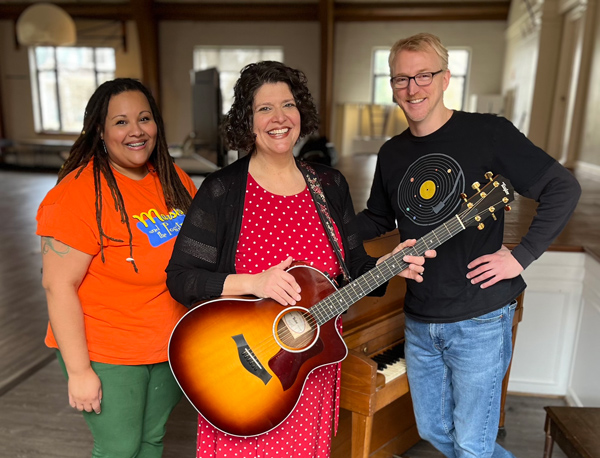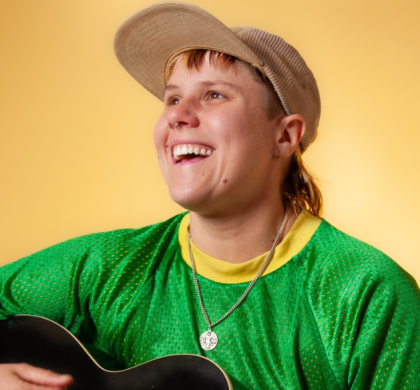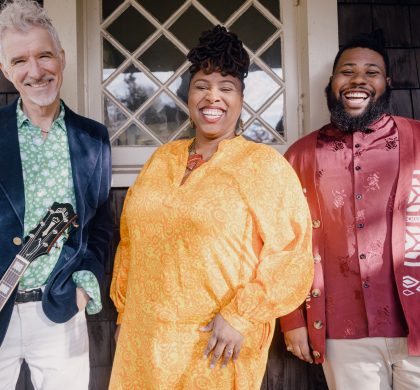Putting a Fun Twist on Science Learning Through Music

Jun 01, 2023
“Kindie” Performer Marsha Goodman-Wood Uses Music to Teach Complex Concepts─and Draws Inspiration from Surprising Places
Marsha Goodman-Wood knows her science! She’s a trained cognitive neuroscientist, and she uses this knowledge as a foundation for her work with children. Goodman-Wood is a teaching artist with Arts for Learning Maryland and Maryland Wolf Trap, and is also the lead in a “Kindie” (kids + indie rock) band, Marsha and the Positrons. She collaborates with fellow family music artists to bring new music to her audience, works with educators and young children to spark creative responses to STEM curriculum in classroom settings, and finds inspiration in conversations with her own children at home─or on long car rides.
Goodman-Wood shares how she uses catchy melodies and playful lyrics to share her love of science with others, and provides some tips to educators who are looking for ways to bring the arts into their own lesson plans:
Question: You take complicated concepts and make them more accessible by transforming them into fun, catchy songs. Can you explain your process?
Goodman-Wood: Each time I write a song it’s a little different, but I usually think up the words and melody together in my head (as opposed to with a musical instrument in hand, or with a paper and pencil or computer in front of me). I might hear a certain phrase that strikes me, and then a melody and rhythm come to mind later, or sometimes the words and melody come at the same time.
Often this happens when I’m busy doing other tasks. Sometimes I get ideas when I’m driving and I have to wait and remember them until I can stop to record them into my phone! I was on a long drive from Philly to DC when I thought of “The Ore Song,” and since I was on the highway and couldn’t stop, I kept singing it to make sure I’d remember the idea. I continued to add as I sang and by the time I was able to sing it into my phone I pretty much had the whole song written!
Q: Do you have a particular area of science you are interested in or that is easiest to write about?
G-W: I’m interested in lots of different topics and like learning about science of all kinds. I find astronomy fascinating, so that’s one area I’m interested in researching and learning more about. When I was in high school I wanted to be a marine biologist, so I may have more songs in me about sea life and marine biology yet to come, too. The area I know most about; the brain, I find hardest to write about. I think because I know a lot about the brain, it was harder to pick and choose what to include and what to leave out!
Q: Do you have any tips for teachers who might not be as musically inclined? How can they still incorporate music and singing as part of their teaching process?
G-W: One activity teachers could do is have students analyze the lyrics and pick out science facts. Another idea is to listen and keep the steady beat by clapping, tapping, or using body percussion. Students could also create dance moves that connect to the topic of the song while they listen (and absorb the facts and messages).
Q: Have you ever collaborated with your own children or students on songs?
G-W: My children and students have definitely inspired songs, usually from conversations or questions. For example, when my middle child was about five years old we were driving on the highway and he noticed the smoke rising from a factory along the side of the road. He looked at all the cars and asked, “What if the cars floated away?” I said, “Well, they can’t because of gravity.” Then he said, “But how do you know they’ll never ever float away?” My husband said, “There’s no vacation from gravity!” That phase stuck in my head and I turned into the title track from my first record, ‘Gravity Vacation,’ which explains the basics of gravity and inertia!
I also do songwriting workshops with students through my teaching artist work. I use a selection of my songs to use as a basis for songwriting parodies, which means students keep the melody and rhythm of the song but come up with their own lyrics. I ask the students to choose a topic they’re interested in and guide them. It’s a fun exercise, and something that teachers can do to encourage students to think creatively about science topics.
For more information on Marsha and the Positrons, visit marshaandthepositrons.com and @MarshaandthePositrons on YouTube. You can find all of their lyrics on the Marsha and the Positrons Bandcamp site. Check out Goodman-Wood has also provided a list of suggested resources for educators below.
Marsha’s Suggested Resources
- New Zealand kindie artist Claudia Robin Gunn (“Little Wild Music”) writes songs about science and makes a lot of wonderful Spotify playlists. (Find Goodson-Wood’s recent collaboration with Gunn, “Thank You Science,” on You Tube: https://youtu.be/f323k2_FtuE, or Spotify.)
- The Children’s Music Network celebrates the positive power of music in the lives of children by sharing songs, exchanging ideas and creating community.
Recommended Posts

Jamming with Jules: Music for Kids of All Ages
Jul 21, 2025 - Education, Experience, For Kids, Institute, Summer


